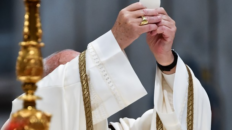When you were a child, how badly did you want to sneak downstairs on Christmas Eve and see what Santa really looked like? You probably imagined him with a big white beard, jolly belly, red cheeks, and fur-lined coat.
But according to scientific analysis and computer models, Saint Nicholas, the 4th century Bishop of Myra who Santa Claus is based on, would have looked a bit different than the Nordic woodsman of popular culture and more like a 4th century Byzantine Bishop.
According to The Saint Nicholas Center:
St. Nicholas’ remains are buried in the crypt of the Basilica di San Nicola in Bari, Italy. These bones were temporarily removed when the crypt was repaired during the 1950s. At the Vatican’s request, anatomy professor Luigi Martino from the University of Bari, took thousands of minutely-detailed measurements and x-ray photographs (roentgenography) of the skull and other bones.

Professor Luigi Martino examining skull of St. Nicholas
Professor of forensic pathology at the University of Bari, Francesco Introna, new advancements in diagnostic technique could yield much more from the data gathered in the 1950s. So in 2004, he engaged expert facial anthropologist, Caroline Wilkinson, then at the University of Manchester in England, to construct a model of the saint’s head from the earlier measurements.
Using this data, the medical artist used state-of-the-art computer software to develop the model of St. Nicholas. The virtual clay was sculpted on a screen using a special tool that allows one to “feel” the clay as it is moulded. Dr Wilkinson says, “In theory, you could do the same thing with real clay, but it’s much easier, far less time-consuming and more reliable to do it on a computer.”

Mark Roughley and Caroline Wilkinson explain development of the new image at St. Nicholas Catholic Primary School in Liverpool
Copyright © 2002-2014 St. Nicholas Center
Caroline Wilkinson updated her original 2004 work ten years later, in 2014. This new image incorporates the latest 3D interactive technology and facial reconstruction system as she had further developed it at the University of Dundee and Liverpool John Moores University. Working in the new Face Lab at the School of Art and Design, she and Mark Roughley have produced a more advanced image using the most up-to-date anatomical standards, tissue depth data from the region, and computer graphic imagery techniques. The result is a middle-aged man with a long beard, round head, and square jaw. St. Nicholas also had a severely broken nose that healed asymmetrically.
“This is the most realistic appearance of St Nicholas based on all the skeletal and historical material. It is thrilling for us to be able to see the face of this famous 4th century Bishop,” said Professor Wilkinson. The new image was unveiled at St. Nicholas Catholic Primary School. The school is adjacent to the LJMU’s School of Art and Design. Wilkinson continued, “It was important to us to involve the local children in the reveal of the latest depiction of the face of St Nicholas and I hope that they will think of his face every year on St Nicholas’s feast day.”

The result of the project is the image of a Greek man, living in Asia Minor (part of the Greek Byzantine Empire), about 60-years old, 5-feet 6-inches tall, who had a heavy jaw and a broken nose.
Press reaction to the facsimile tended to imply that good Saint Nicholas had had a brawling past, hence the broken nose. It is more likely, however, that his nose was broken when imprisoned and tortured during the persecution of Christians under Roman Emperor Diocletian.



